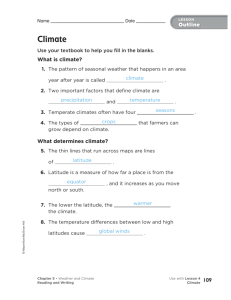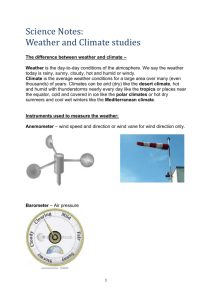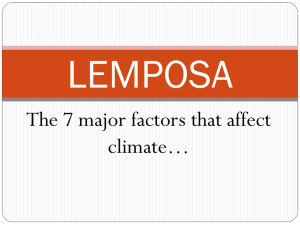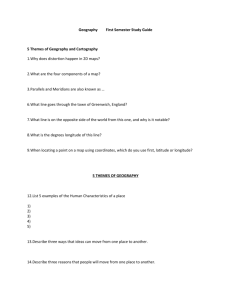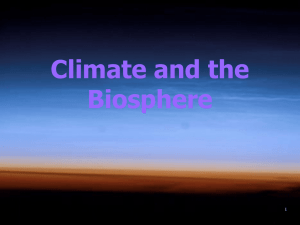Name___________ Practice Questions
advertisement
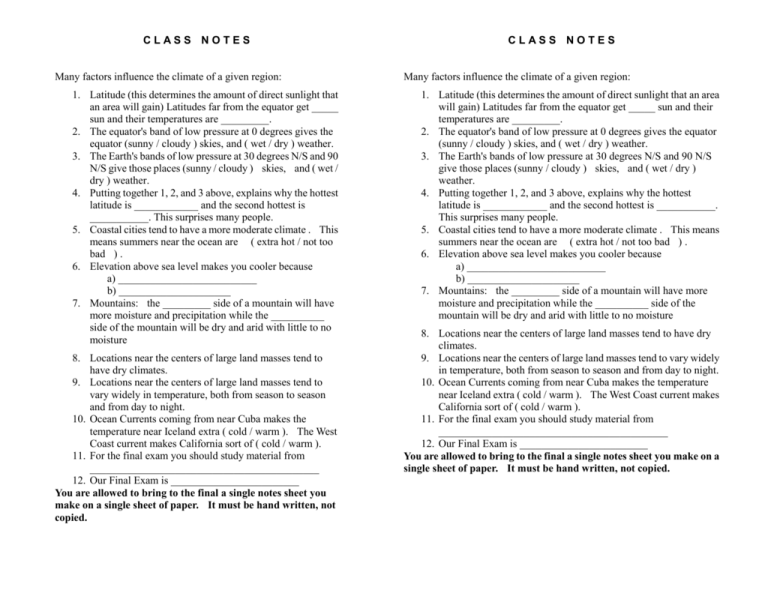
CLASS NOTES Many factors influence the climate of a given region: 1. Latitude (this determines the amount of direct sunlight that an area will gain) Latitudes far from the equator get _____ sun and their temperatures are _________. 2. The equator's band of low pressure at 0 degrees gives the equator (sunny / cloudy ) skies, and ( wet / dry ) weather. 3. The Earth's bands of low pressure at 30 degrees N/S and 90 N/S give those places (sunny / cloudy ) skies, and ( wet / dry ) weather. 4. Putting together 1, 2, and 3 above, explains why the hottest latitude is ____________ and the second hottest is ___________. This surprises many people. 5. Coastal cities tend to have a more moderate climate . This means summers near the ocean are ( extra hot / not too bad ) . 6. Elevation above sea level makes you cooler because a) __________________________ b) _____________________ 7. Mountains: the _________ side of a mountain will have more moisture and precipitation while the __________ side of the mountain will be dry and arid with little to no moisture 8. Locations near the centers of large land masses tend to have dry climates. 9. Locations near the centers of large land masses tend to vary widely in temperature, both from season to season and from day to night. 10. Ocean Currents coming from near Cuba makes the temperature near Iceland extra ( cold / warm ). The West Coast current makes California sort of ( cold / warm ). 11. For the final exam you should study material from ___________________________________________ 12. Our Final Exam is ________________________ You are allowed to bring to the final a single notes sheet you make on a single sheet of paper. It must be hand written, not copied. CLASS NOTES Many factors influence the climate of a given region: 1. Latitude (this determines the amount of direct sunlight that an area will gain) Latitudes far from the equator get _____ sun and their temperatures are _________. 2. The equator's band of low pressure at 0 degrees gives the equator (sunny / cloudy ) skies, and ( wet / dry ) weather. 3. The Earth's bands of low pressure at 30 degrees N/S and 90 N/S give those places (sunny / cloudy ) skies, and ( wet / dry ) weather. 4. Putting together 1, 2, and 3 above, explains why the hottest latitude is ____________ and the second hottest is ___________. This surprises many people. 5. Coastal cities tend to have a more moderate climate . This means summers near the ocean are ( extra hot / not too bad ) . 6. Elevation above sea level makes you cooler because a) __________________________ b) _____________________ 7. Mountains: the _________ side of a mountain will have more moisture and precipitation while the __________ side of the mountain will be dry and arid with little to no moisture 8. Locations near the centers of large land masses tend to have dry climates. 9. Locations near the centers of large land masses tend to vary widely in temperature, both from season to season and from day to night. 10. Ocean Currents coming from near Cuba makes the temperature near Iceland extra ( cold / warm ). The West Coast current makes California sort of ( cold / warm ). 11. For the final exam you should study material from ___________________________________________ 12. Our Final Exam is ________________________ You are allowed to bring to the final a single notes sheet you make on a single sheet of paper. It must be hand written, not copied. Name___________ Practice Questions: Use p.467 and your old notes. Those two places in North America have different climates How is their temperature different? How is their precipitation different? 1 It's not different. 2 It's not different. 3 4 5. Based only on sun, as latitude increases, temperature ____________________ because ____________________________________________________________________________ 6. Low pressure is associated with __________________________ weather while high pressure is associated with _______________________________ weather. 7. As altitude increases, temperature ________________________ because _________________ ____________________________________________________________________________ 8. Many people are surprised that the Tropics have hotter average temperatures than the Equator. This is because the Equator has large insolation but it also has _________________________ 9. Circle one or more answers. The Earth has a band of relatively low pressure at the Latitude of 90S 30S 0 30N 90N 10. Circle one or more answers. The Earth has a band of relatively high pressure at the Latitude of 90S 30S 0 30N 90N 11. Label these 12 month temperature graphs as being from “center of continent” or “marine environment” _______________________________ _______________________________ 12. Label these two towns as “windward side of the mountain” or “leeward side of the mountain” _______________________________ _______________________________ 13. Locations that are near large bodies of water tend to have __________________ summers and ____________________ winters than location that are inland. 14. Shade in the parts of this continent which will have marine environment. 15. Describe what happens to air as it sinks (as it may on the leeward side of a mountain range). ____________________________________________________________________ 16. Circle one or more answers. There is a band of relatively dry climates at the Latitude of 90S 30S 0 30N 90N 17. Circle one or more answers. There is a band of relatively high precipitation climates at the Latitude of 90S 30S 0 30N 90N In each of the five boxes, write a letter of a location from the imaginary continent.
